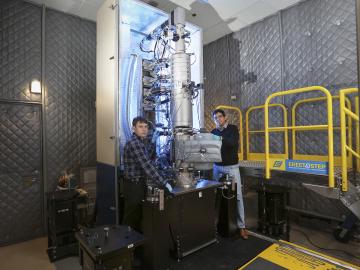
Filter News
Area of Research
- (-) Computational Engineering (2)
- (-) Materials (99)
- Advanced Manufacturing (3)
- Biological Systems (2)
- Biology and Environment (138)
- Biology and Soft Matter (1)
- Computational Biology (2)
- Computer Science (4)
- Electricity and Smart Grid (3)
- Energy Frontier Research Centers (1)
- Energy Science (126)
- Functional Materials for Energy (1)
- Fusion and Fission (8)
- Isotopes (26)
- Materials for Computing (15)
- Mathematics (1)
- National Security (22)
- Neutron Science (124)
- Nuclear Science and Technology (11)
- Quantum information Science (3)
- Sensors and Controls (1)
- Supercomputing (88)
News Topics
- (-) Bioenergy (11)
- (-) Biomedical (8)
- (-) Environment (21)
- (-) Exascale Computing (2)
- (-) Grid (5)
- (-) Isotopes (13)
- (-) Nanotechnology (39)
- (-) Neutron Science (33)
- 3-D Printing/Advanced Manufacturing (23)
- Advanced Reactors (4)
- Artificial Intelligence (10)
- Big Data (3)
- Biology (5)
- Buildings (5)
- Chemical Sciences (32)
- Clean Water (4)
- Composites (9)
- Computer Science (21)
- Coronavirus (4)
- Critical Materials (13)
- Cybersecurity (4)
- Energy Storage (34)
- Frontier (3)
- Fusion (7)
- High-Performance Computing (5)
- Irradiation (1)
- ITER (1)
- Machine Learning (6)
- Materials (73)
- Materials Science (78)
- Mathematics (2)
- Mercury (1)
- Microscopy (27)
- Molten Salt (3)
- National Security (3)
- Nuclear Energy (16)
- Partnerships (11)
- Physics (28)
- Polymers (17)
- Quantum Computing (3)
- Quantum Science (11)
- Security (2)
- Simulation (1)
- Space Exploration (2)
- Summit (3)
- Transportation (14)
Media Contacts

The Department of Energy’s Oak Ridge National Laboratory is now producing actinium-227 (Ac-227) to meet projected demand for a highly effective cancer drug through a 10-year contract between the U.S. DOE Isotope Program and Bayer.

“Made in the USA.” That can now be said of the radioactive isotope molybdenum-99 (Mo-99), last made in the United States in the late 1980s. Its short-lived decay product, technetium-99m (Tc-99m), is the most widely used radioisotope in medical diagnostic imaging. Tc-99m is best known ...

A scientific team led by the Department of Energy’s Oak Ridge National Laboratory has found a new way to take the local temperature of a material from an area about a billionth of a meter wide, or approximately 100,000 times thinner than a human hair. This discove...

A novel method developed at Oak Ridge National Laboratory creates supertough renewable plastic with improved manufacturability. Working with polylactic acid, a biobased plastic often used in packaging, textiles, biomedical implants and 3D printing, the research team added tiny amo...

A team led by the Department of Energy’s Oak Ridge National Laboratory has identified a novel microbial process that can break down toxic methylmercury in the environment, a fundamental scientific discovery that could potentially reduce mercury toxicity levels and sup...

For more than 50 years, scientists have debated what turns particular oxide insulators, in which electrons barely move, into metals, in which electrons flow freely.


